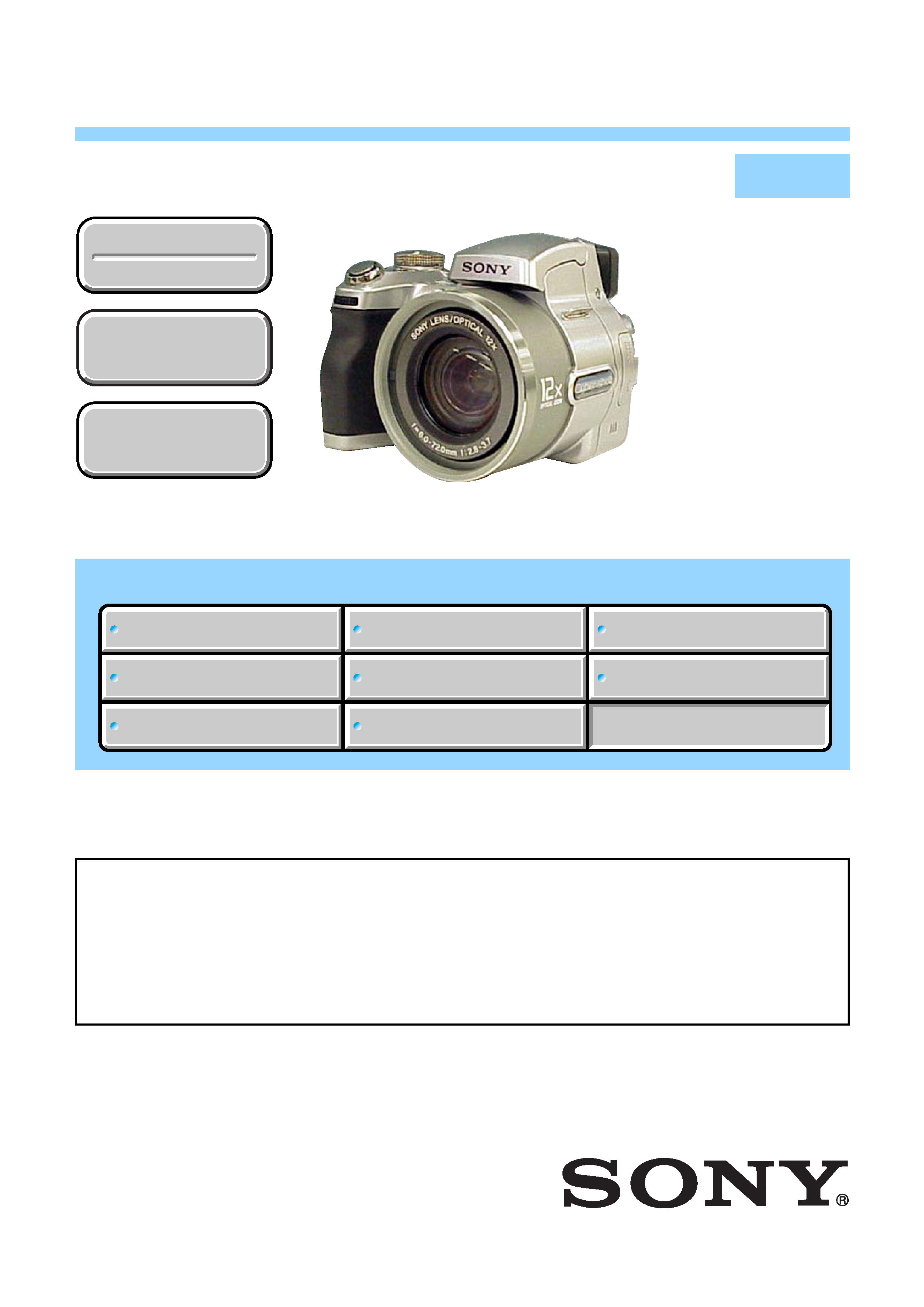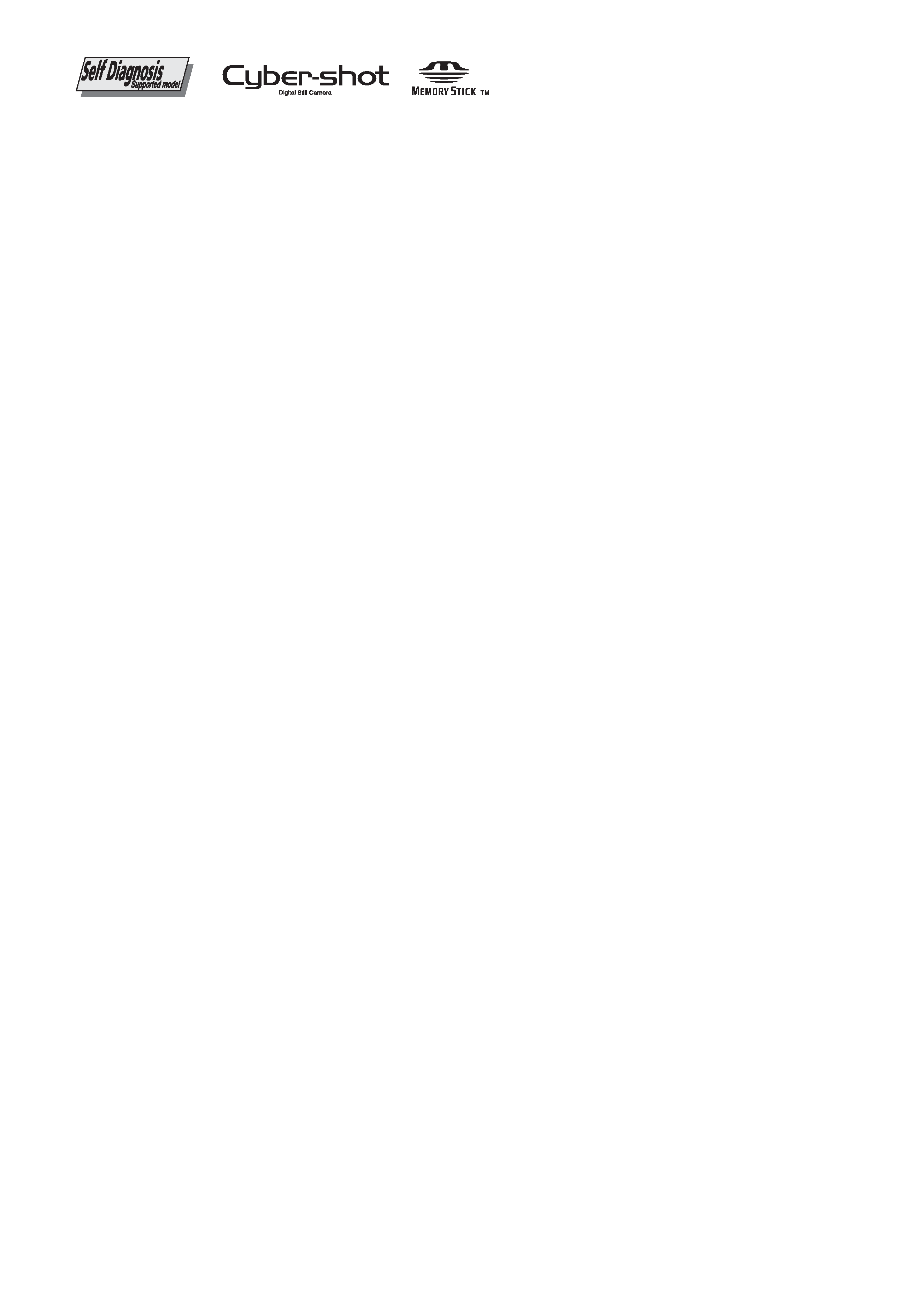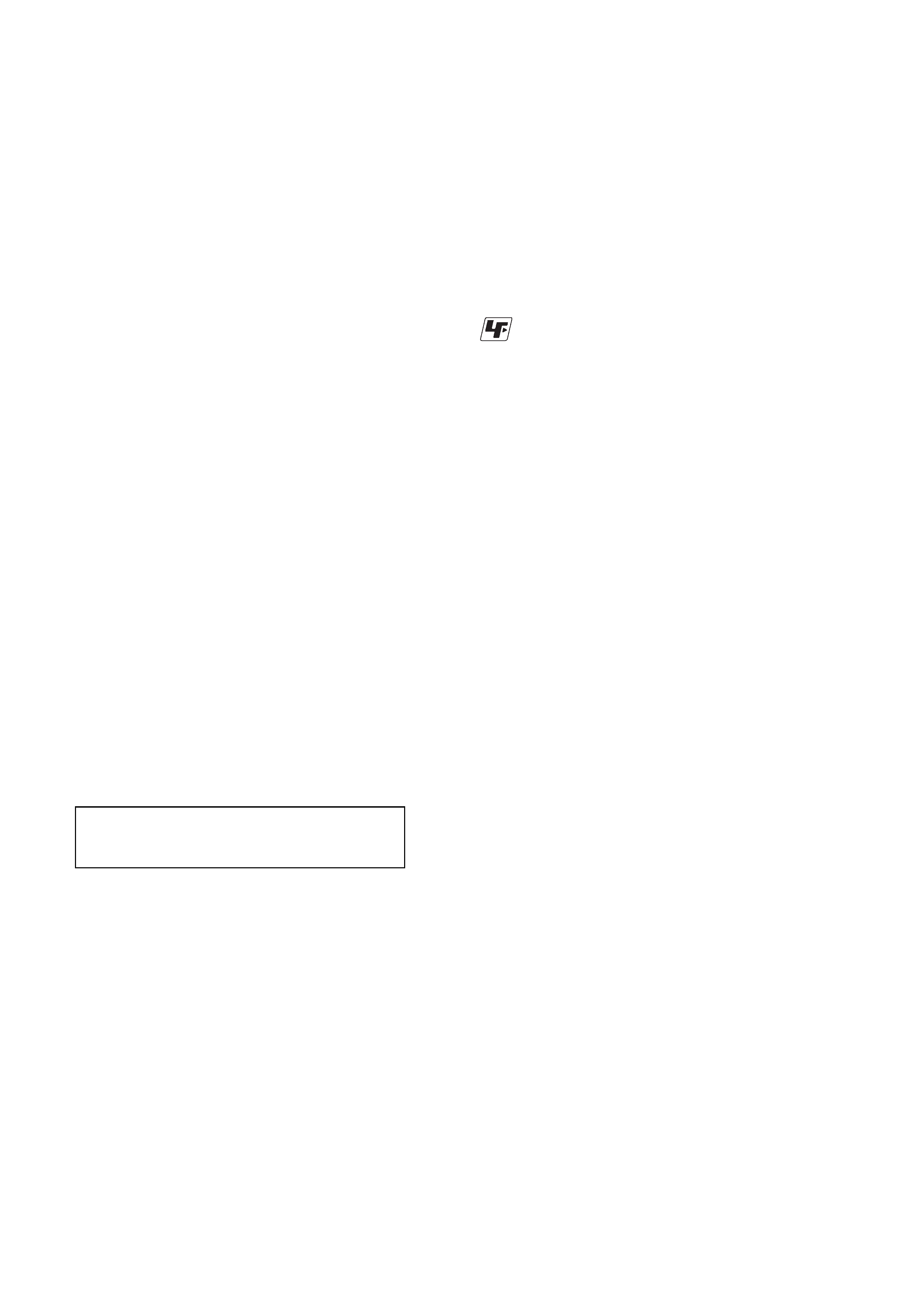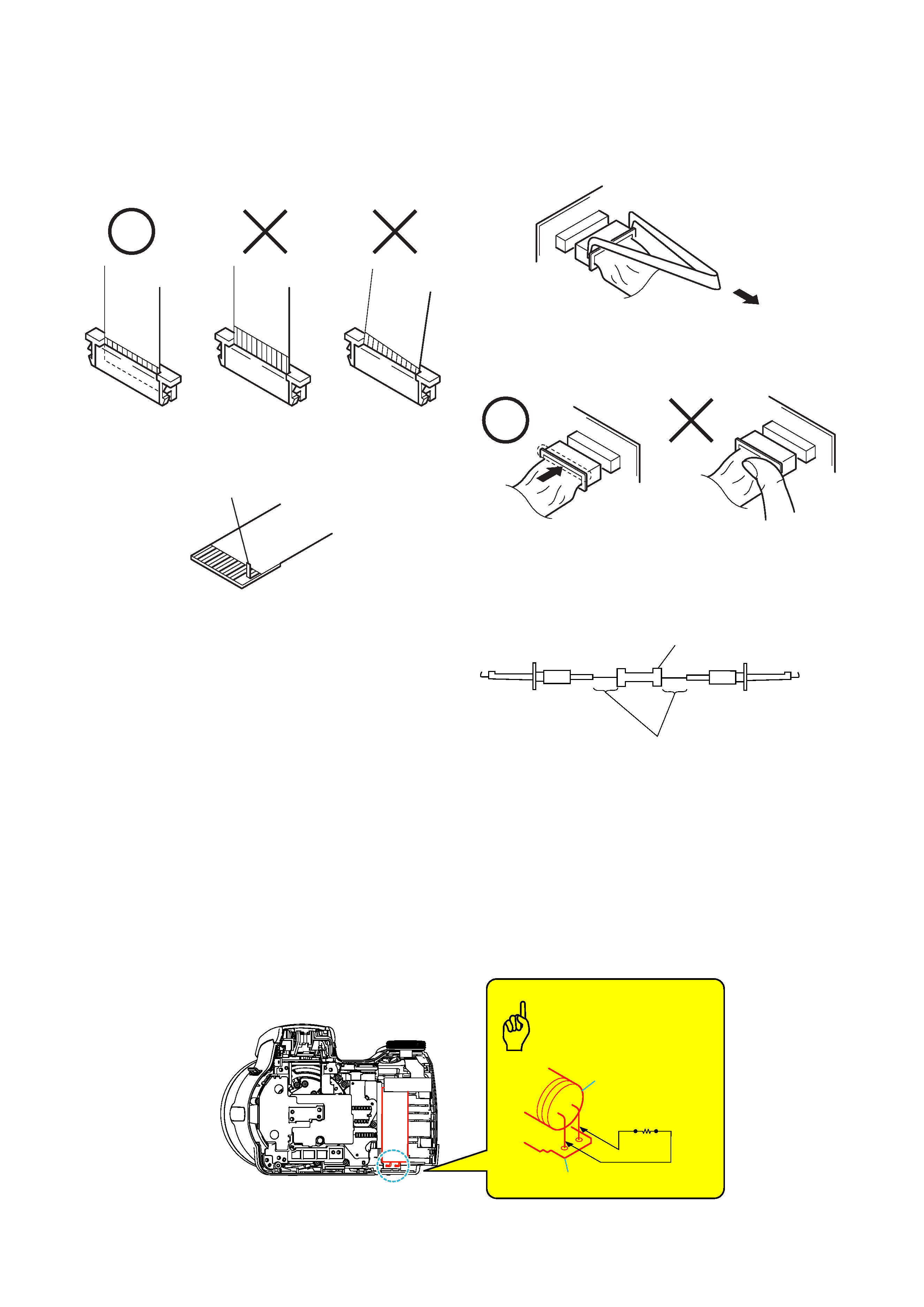
SERVICE MANUAL
DIGITAL STILL CAMERA
Link
SERVICE NOTE
DISASSEMBLY
BLOCK DIAGRAMS
FRAME SCHEMATIC DIAGRAMS
SCHEMATIC DIAGRAMS
PRINTED WIRING BOARDS
REPAIR PARTS LIST
SPECIFICATIONS
SERVICE NOTE
DISASSEMBLY
BLOCK DIAGRAMS
FRAME SCHEMATIC DIAGRAMS
SCHEMATIC DIAGRAMS
PRINTED WIRING BOARDS
REPAIR PARTS LIST
SPECIFICATIONS
Link
Revision History
Revision History
Ver 1.0 2005. 04
On the CH-169 and SY-127 board
This service manual provides the information that is premised the circuit board replacement service and not intended repair
inside the SY-127 board.
Therefore, schematic diagram, printed wiring board, mounted parts location and electrical parts list of the SY-127 board are not
shown.
The following pages are not shown.
Mounted parts location ............................. Page 4-64
Electrical parts list ................................... Pages 5-14 to 5-18
How to use
Acrobat Reader
How to use
Acrobat Reader
Schematic diagram ............................. Pages 4-21 to 4-44
Printed wiring board ............................ Pages 4-55 to 4-60
Waveforms ........................................... Page 4-62
Sony EMCS Co.
2005D1600-1
©2005.4
Published by DI Technical Support Section
9-876-880-31
DSC-H1
DSC-H1
DSC-H1
US Model
Canadian Model
AEP Model
UK Model
E Model
Hong Kong Model
Australian Model
Chinese Model
Japanese Model
Korea Model
Tourist Model
· For ADJUSTMENTS (SECTION 6), refer to SERVICE MANUAL, ADJ (9-876-880-51).
Internal memory
ON BOARD
Internal memory
ON BOARD

-- 2 --
DSC-H1
SPECIFICATIONS
Camera
[System]
Image device
7.19 mm (1/2.5 type) color
CCD, Primary color filter
Total pixel number of camera
Approx. 5 255 000 pixels
Effective pixel number of camera
Approx. 5 127 000 pixels
Lens
12 zoom lens
f = 6.0 - 72.0 mm (36 - 432 mm
when converted to a 35 mm still
camera)
F2.8 - 3.7
Exposure control Automatic exposure, Shutter
speed priority, Aperture
priority, Manual exposure,
Scene Selection (7 modes)
White balance
Automatic, Daylight, Cloudy,
Fluorescent, Incandescent,
Flash, One push
File format (DCF compliant)
Still images: Exif Ver. 2.2
JPEG compliant, DPOF
compatible
Movies: MPEG1 compliant
(Monaural)
Recording media Internal memory 32 MB
"Memory Stick"
Flash
Recommended distance (ISO
set to Auto): 0.3 m to 6.8 m
(11 26/32 inches to 22 feet
3 23/32 inches) (W)/0.9 m to
5.2 m (2 feet 11 14/32 inches to
17 feet 23/32 inches) (T)
Viewfinder
Electric viewfinder (color)
[Input and Output connectors]
A/V OUT (MONO) jack (Monaural)
Minijack
Video: 1 Vp-p, 75
,
unbalanced, sync negative
Audio: 327 mV (at a 47 k
load)
Output impedance 2.2 k
USB jack
mini-B
USB communication
Hi-Speed USB (USB 2.0
compliant)
[LCD screen]
LCD panel
6.2 cm (2.5 type) TFT drive
Total number of dots
115 200 (480x240) dots
[Finder]
LCD panel
0.75 cm (0.3 type) TFT drive
Total number of dots
115 200 (480x240) dots
[Power, general]
Power
HR 15/51:HR6 (size AA)
Nickel-Metal Hydride batteries
(2), 2.4 V
ZR6 (size AA) Oxy Nickel
Primary Battery (2, not
supplied), 3 V
AC-LS5K AC Adaptor (not
supplied), 4.2 V
Power consumption
(during shooting with the LCD screen)
1.8 W
Operating temperature
0
°C to +40°C (+32°F to
+104
°F)
Storage temperature
20
°C to +60°C (4°F to
+140
°F)
Dimensions
108x81.4x91.2 mm
(4 1/4x 31/4x 35/8 inches)
(W/H/D, excluding maximum
protrusions)
Mass
Approx. 590.8 g (1 lb 20.8 oz)
(including two batterries,
shoulder strap, adaptor ring,
lens hood, lens cap, etc.)
Microphone
Electret condenser microphone
Speaker
Dynamic speaker
Exif Print
Compatible
PRINT Image Matching III
Compatible
PictBridge
Compatible
BC-CS2A/CS2B Ni-MH battery charger
Power requirements
AC 100 to 240 V, 50/60 Hz,
3 W
Output voltage
AA: DC 1.4V 400 mAx2
AAA: DC 1.4 V 160 mAx2
Operating temperature
0
°C to +40°C (+32°F to
+104
°F)
Storage temperature
20
°C to +60°C (4°F to
+140
°F)
Dimensions
Approx. 71x30x91 mm
(2 7/8x 13/16x 35/8 inches)
(W/H/D)
Mass
Approx. 90 g (3 oz)
Design and specifications are subject to change
without notice.

-- 3 --
DSC-H1
1.
Check the area of your repair for unsoldered or poorly-soldered
connections. Check the entire board surface for solder splashes
and bridges.
2.
Check the interboard wiring to ensure that no wires are
"pinched" or contact high-wattage resistors.
3.
Look for unauthorized replacement parts, particularly
transistors, that were installed during a previous repair. Point
them out to the customer and recommend their replacement.
4.
Look for parts which, through functioning, show obvious signs
of deterioration. Point them out to the customer and
recommend their replacement.
5.
Check the B+ voltage to see it is at the values specified.
6.
Flexible Circuit Board Repairing
· Keep the temperature of the soldering iron around 270°C
during repairing.
· Do not touch the soldering iron on the same conductor of the
circuit board (within 3 times).
· Be careful not to apply force on the conductor when soldering
or unsoldering.
Unleaded solder
Boards requiring use of unleaded solder are printed with the lead-
free mark (LF) indicating the solder contains no lead.
(Caution: Some printed circuit boards may not come printed with
the lead free mark due to their particular size.)
: LEAD FREE MARK
Unleaded solder has the following characteristics.
· Unleaded solder melts at a temperature about 40
°C higher than
ordinary solder.
Ordinary soldering irons can be used but the iron tip has to be
applied to the solder joint for a slightly longer time.
Soldering irons using a temperature regulator should be set to
about 350
°C.
Caution: The printed pattern (copper foil) may peel away if the
heated tip is applied for too long, so be careful!
· Strong viscosity
Unleaded solder is more viscous (sticky, less prone to flow) than
ordinary solder so use caution not to let solder bridges occur such
as on IC pins, etc.
· Usable with ordinary solder
It is best to use only unleaded solder but unleaded solder may
also be added to ordinary solder.
SAFETY CHECK-OUT
After correcting the original service problem, perform the following
safety checks before releasing the set to the customer.
SAFETY-RELATED COMPONENT WARNING!!
COMPONENTS IDENTIFIED BY MARK 0 OR DOTTED LINE WITH
MARK 0 ON THE SCHEMATIC DIAGRAMS AND IN THE PARTS
LIST ARE CRITICAL TO SAFE OPERATION. REPLACE THESE
COMPONENTS WITH SONY PARTS WHOSE PART NUMBERS
APPEAR AS SHOWN IN THIS MANUAL OR IN SUPPLEMENTS
PUBLISHED BY SONY.
ATTENTION AU COMPOSANT AYANT RAPPORT
À LA SÉCURITÉ!
LES COMPOSANTS IDENTIFÉS PAR UNE MARQUE 0 SUR LES
DIAGRAMMES SCHÉMATIQUES ET LA LISTE DES PIÈCES SONT
CRITIQUES POUR LA SÉCURITÉ DE FONCTIONNEMENT. NE
REMPLACER CES COMPOSANTS QUE PAR DES PIÈSES SONY
DONT LES NUMÉROS SONT DONNÉS DANS CE MANUEL OU
DANS LES SUPPÉMENTS PUBLIÉS PAR SONY.
CAUTION :
Danger of explosion if battery is incorrectly replaced.
Replace only with the same or equivalent type.

-- 4 --
DSC-H1
TABLE OF CONTENTS
1.
SERVICE NOTE ........................................................ 1-1
2.
DISASSEMBLY
2-1.
DISASSEMBLY ······························································ 2-1
2-2.
SERVICE POSITION ····················································· 2-5
2-3.
CIRCUIT BOARDS LOCATION ··································· 2-7
2-4.
FLEXIBLE BOARDS LOCATION ································ 2-8
HELP (List of caution points is shown here.)
3.
BLOCK DIAGRAMS
3-1.
OVERALL BLOCK DIAGRAM (1/2) ··························· 3-1
3-2.
OVERALL BLOCK DIAGRAM (2/2) ··························· 3-3
3-3.
POWER BLOCK DIAGRAM (1/2) ································ 3-5
3-4.
POWER BLOCK DIAGRAM (2/2) ································ 3-7
4.
PRINTED WIRING BOARDS AND
SCHEMATIC DIAGRAMS
4-1.
FRAME SCHEMATIC DIAGRAM ································ 4-1
4-2.
SCHEMATIC DIAGRAMS
· CD-576 (CCD IMAGER)
SCHEMATIC DIAGRAM ······························ 4-5
· MS-275 (MEMORY STICK, LI BATTERY)
SCHEMATIC DIAGRAM ······························ 4-7
· ST-123 (FLASH DRIVE)
SCHEMATIC DIAGRAM ······························ 4-9
· ST-124 (FLASH)
SCHEMATIC DIAGRAM ···························· 4-17
· PL-039 (PLUNGER)
SCHEMATIC DIAGRAM ······························ 4-8
· SW-447 (1/2) (FUNCTION SW)
SCHEMATIC DIAGRAM ···························· 4-11
· SW-447 (2/2) (PITCH/YAW SENSOR AMP)
SCHEMATIC DIAGRAM ···························· 4-13
· EV-016 (EVF, BACK LIGHT)
SCHEMATIC DIAGRAM ······························ 4-7
· AF-102 FLEXIBLE (AF LED, LENS COVER SW)
SCHEMATIC DIAGRAM ···························· 4-15
· SW-006 FLEXIBLE (SY-SW RELAY)
SCHEMATIC DIAGRAM ···························· 4-18
· MS-029 FLEXIBLE (SY-MS RELAY)
SCHEMATIC DIAGRAM ···························· 4-15
· ST-001 FLEXIBLE (SY-ST RELAY)
SCHEMATIC DIAGRAM ···························· 4-17
· FP-224 FLEXIBLE (SY-CD RELAY)
SCHEMATIC DIAGRAM ···························· 4-16
· CONTROL SWITCH BLOCK (SW51780)
SCHEMATIC DIAGRAM ···························· 4-19
Shematic diagram of the CH-169 and SY-127 board
are not shown.
Pages from 4-21 to 4-44 are not shown.
4-3.
PRINTED WIRING BOARDS
· CD-576 (CCD IMAGER)
PRINTED WIRING BOARD ······················· 4-49
· MS-275 (MEMORY STICK, LI BATTERY)
PRINTED WIRING BOARD ······················· 4-47
· ST-123 (FLASH DRIVE)
PRINTED WIRING BOARD ······················· 4-51
· ST-124 (FLASH)
PRINTED WIRING BOARD ······················· 4-52
· PL-039 (PLUNGER)
PRINTED WIRING BOARD ······················· 4-51
· SW-447 (FUNCTION SW, PITCH/YAW SENSOR AMP)
PRINTED WIRING BOARD ······················· 4-53
· EV-016 (EVF, BACK LIGHT)
PRINTED WIRING BOARD ······················· 4-49
· AF-102 FLEXIBLE (AF LED, LENS COVER SW)
PRINTED WIRING BOARD ······················· 4-47
Printed wiring board of the CH-169 and SY-127 board
are not shown.
Pages from 4-55 to 4-60 are not shown.
4-4.
WAVEFORMS ······························································ 4-61
Waveforms of the SY-127 board are not shown.
Page 4-62 is not shown.
4-5.
MOUNTED PARTS LOCATION ································· 4-63
Mounted parts location of the SY-127 board is not
shown.
Page 4-64 is not shown.
5.
REPAIR PARTS LIST
5-1.
EXPLODED VIEWS ······················································ 5-3
5-1-1. OVERALL SECTION ···················································· 5-3
5-1-2. LED SECTION, CABINET(REAR) SECTION ············ 5-4
5-1-3. MAIN SECTION ··························································· 5-5
5-1-4. EVF SECTON ······························································· 5-6
5-1-5. LENS SECTION ··························································· 5-7
5-1-6. CABINET(FRONT) SECTION ····································· 5-8
5-1-7. ST SECTION ································································· 5-9
Checking supplied accessories ················································ 5-10
5-2.
ELECTRICAL PARTS LIST ········································ 5-11
Electrical parts list of the SY-127 board are not
shown.
Pages from 5-14 to 5-18 are not shown.

1-1
DSC-H1
1. SERVICE NOTE
· NOTE FOR REPAIR
[Discharging of the FLASH unit's charging capacitor]
The charging capacitor of the FLASH unit is charged up to the
maximum 300 V potential.
There is a danger of electric shock by this high voltage when the
capacitor is handled by hand. The electric shock is caused by the
charged voltage which is kept without discharging when the main
power of the DSC-H1 is simply turned off. Therefore, the remaining
voltage must be discharged as described below.
Preparing the Short Jig
To preparing the short jig. a small clip is attached to each end of a
resistor of 1 k
/1 W (1-215-869-11)
Wrap insulating tape fully around the leads of the resistor to prevent
electrical shock.
1 k
/1 W
Wrap insulating tape.
Make sure that the flat cable and flexible board are not cracked of
bent at the terminal.
Do not insert the cable insufficiently nor crookedly.
Cut and remove the part of gilt
which comes off at the point.
(Take care that there are
some pieces of gilt left inside)
When remove a connector, don't pull at wire of connector.
Be in danger of the snapping of a wire.
When installing a connector, don't press down at wire of connector.
Be in danger of the snapping of a wire.
Discharging the Capacitor
1
Remove the main section.
2
Discharge the capacitor on the ST-123 board for about 10 seconds
by using the short jig.
1
Discharging the capacitor
Capacitor
ST-123 board
Short jig (1k
/1W)
Caution
